Bearded dragons are popular pets, and a topic of interest for many. This article will highlight the differences between males and females of the species. What makes your cherished pet a male vs female bearded dragon?
It is important to note that there are no distinguishable features on a bearded dragon that can be used to definitively determine sex. In order to accurately determine the sex of your pet you must get its blood test results from a vet, who can give you an accurate gender diagnosis using chromatography.
There exists one exception of being able to tell the difference by looking at their coloration, which we will explore later.
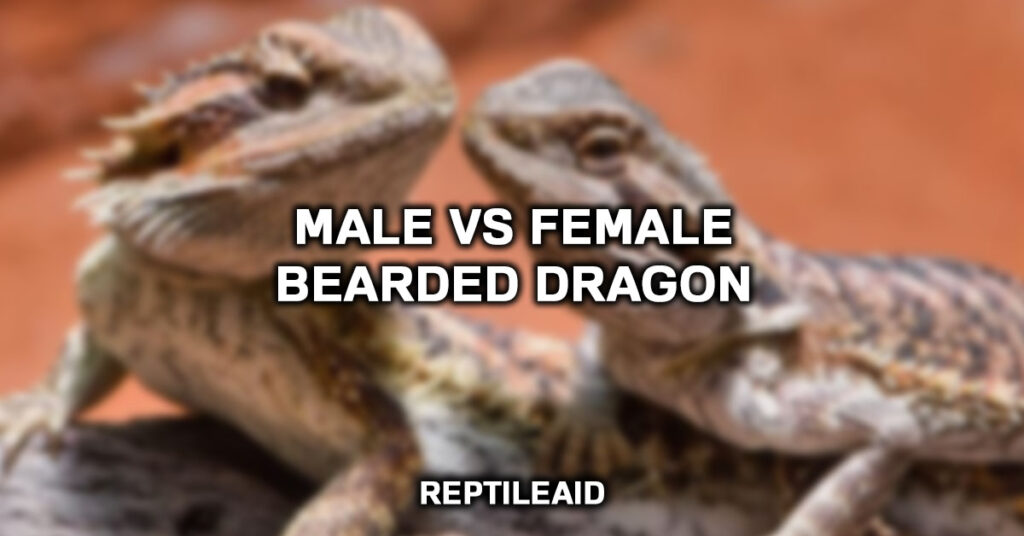
What’s the difference between a male and a female bearded dragon?
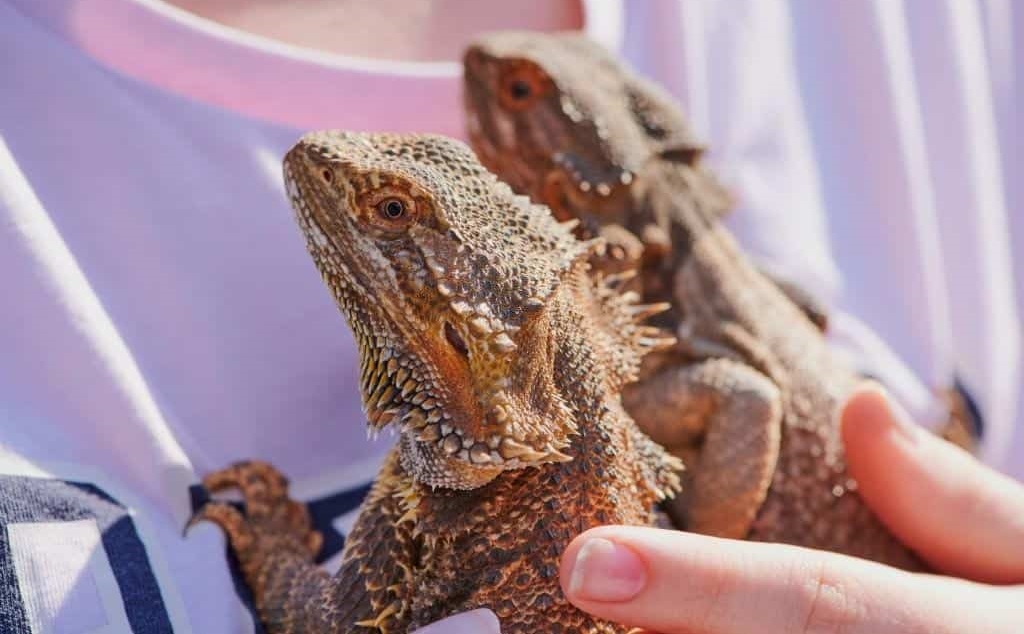
First, let’s explore what makes a bearded dragon a “he” or a “she”. Much of this information comes from studies done in the internal examination. So let’s take a look.
Male bearded dragons are slightly larger than females. On average, adult male Bearded Dragons will range in size from 24-30 inches (including the tail) and an adult female can grow to be 24-26 inches (including the tail).
A male’s hemipenes (sex organ on the belly side of reptiles that carries sperm) are more pronounced than a female’s. The hemipenes of the male are usually visible through their scales while it is harder for them to see on a female because they lay flat against their body.
Females typically have less pronounced patterns than males of the same age this is due to their skin being thicker through maturing. However, there are always exceptions to these rules! Sometimes you might have a female that has very bold patterns and some males which have very faint patterns.
In the same sense, there are always some females that will never show their hemipenes as well as some males that may not either.
Quick Fact: Another characteristic is the beard of a bearded dragon. While both sexes have a “beard” on their bellies, it tends to grow more in length on a male than on a female. This happens because the male’s testes release more testosterone than a female does.
Females can put out just as much or even more light tan coloring than males might with extended beards through diet and time spent basking under lights, so keep this in mind!
The most common way to sex them is by lifting them up and having a look under them.
More typically, males have larger heads than females and another difference is the opening on the bottom side of their jaw. This area can be used to determine sex as well if you don’t want to use size or coloration for help.
Males tend to have more pronounced “turrets” which stick out from their bottom-side jaw than female beardies do. Also, because this opening is where they actually go to the bathroom, it tends to smell different depending on which sex your bearded dragon is so much so that you might even be able to figure it out by smell alone!
A final way that people will sometimes try and tell a male from a female Bearded Dragon is by looking at their front arms. Males tend to have more pronounced “brachia” which are the spines that stick out from their forearms.
Females tend to have longer, thinner forearms with less obvious spines protruding from them, however not all females will follow these rules so if you’re looking for a sure way to tell the difference between sexes without your bearded dragon’s blood work results, there is only one way that can be done!
Now let us take a look at how coloration may also help sex your bearded dragon. It should be noted that this information can vary due to age diet and time spent under different lighting conditions so once again it may not always show accurate differences between sexes.
Male Bearded Dragons are typically a bit more vibrant in appearance than females. Males have a richer red color on their sides and vivid blue markings along the sides of their faces that females do not have. Females tend to have a more muted brownish coloration with yellow or orange accents that males do not typically have, however, there are always exceptions to these rules.
Once again, since the skin of a female is thicker it can be harder to see early differences especially if they haven’t been “puffed” out under lights for basking yet while eating well.
The colors on bearded dragons also change depending on things like sex hormone levels, times of day, and overall health, so make sure your bearded dragon is healthy before you try using their colors as an indicator of sex.
Many people will use both the appearance of their beard and puffed out the coloring of their belly as an indicator for sexing bearded dragons, however, you should only do this if your bearded dragon has proper UVB lighting and eats a well-balanced diet full of vegetables and insects.
If they don’t have the right conditions to create these nitrates needed for coloration changes or their beard to grow in fully, then you can not accurately tell what sex your bearded dragon is just by looking at it!
In short, males tend to have larger heads with longer beards than females but this isn’t always true in every single case. Females may have thicker skin which makes them harder to see from under scales and harder to sex based on coloring. Females tend to look drab than males but again, this is not always the case with every single one.
If you can’t tell male from female by these subtle differences it is best to wait until they are sexually mature and their colors have evened out across their bodies before basing your answer on that or having them tested in a reptile veterinarian’s office.
Different people may find different methods work best for them, just keep trying if one doesn’t seem to work. The exception here is bearded dragons with parietal eye lesions. If your beardie has had an eye injury then this procedure becomes much more difficult.
You can also find out what sex your bearded dragon is by its coloration. This method works well for hatchlings under one year old. On an adult, it becomes extremely difficult, if not impossible to accurately determine whether they are a boy or girl based on the coloration alone.
The reason for this is that as it ages their coloring will become more similar regardless of whether they are a male or female. In general, there seem to be three genders that correspond with three colors:
- Gender 1: Blue/Purple
- Gender 2: Yellow
- Gender 3: Red
Some very young bearded dragons will be what is called “intersex” or an “XX/XY chimera”, meaning that they are genetically both male and female. If you find yourself in this situation don’t worry, it’s not too unusual (about 1-3% of births) and it usually goes away within the first year.
The other way to tell apart your bearded dragon’s gender is something called temperature-dependent sex determination (TSD). This method works best for hatchlings, but it can sometimes work on adults as well. What happens during TSD is that the eggs incubated at a high temperature produce females while eggs incubated at a lower temperature produce males.
So what affects the temperatures? Well, that’s simple enough, it’s the way you’ve incubated your eggs.
TSD is a form of environmental sex determination which means that the temperature when the egg is being developed affects whether it will be male or female. In contrast, in genetic-based sex determination, the sex chromosomes an organism has determine its developmental fate (XY produces a male and XX a female).
Under normal circumstances, all eggs start with the same genetic information at the time they are fertilized but then go through different pathways depending on developmental cues given by their environment. In TSD the developmental cue to develop into a male comes from low temperatures during development, while high temperatures trigger development in females.
If you are still confused about the bearded dragon’s gender after using all three methods together then don’t worry. You can always ask for help on forums or other online communities, but remember that it takes time to figure out your beardies’ gender by yourself.
Don’t be discouraged if you aren’t able to figure it out quickly, some people took up to two years until they were sure of what sex their beardie was!
What Age Can You Tell The Difference?
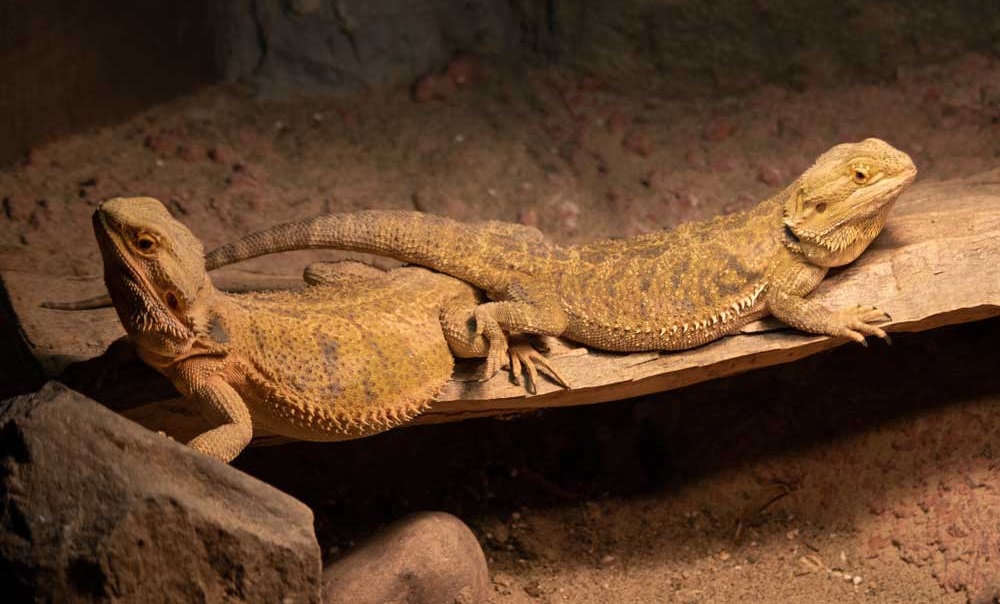
It is very difficult to tell the difference between male and female bearded dragons before they reach sexual maturity (6-12 months of age). After puberty, it’s easier to determine their sex.
It is becoming easier to tell the difference between males and females as they age (after 12 months of age).
For example, a male can be distinguished from a female because he has hemipenes that will protrude out of his cloaca, whereas on a female it will fold back into her body.
Also on some occasions, if you look closely enough at their vent you may be able to see whether or not she has any eggs stored in her oviducts. You might also be able to notice whether they have ever mated before by examining their state of them, which typically involves some sort of knotting.
Quick Fact: One last way to tell the difference between a male and a female is that males have a row of pre-anal pores, which are used to release pheromones during mating.
How can you tell if a bearded dragon is male?
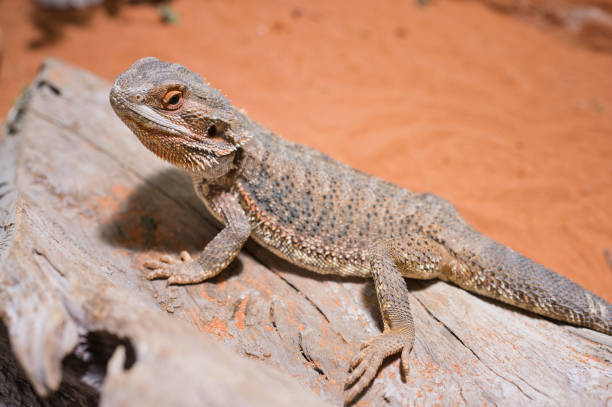
There are three ways you can tell if a bearded dragon is male, by looking at its coloration, by checking for hemipenes, and by pressing on their chest. Males tend to have vivid coloring around their heads and necks as well as brightly colored bands across their backs.
Males also have two small sacs located halfway down each side of the tail which contain the hemipenes (or diodes). They tend to have more of a triangular-shaped head while the females are more rounded. Males will also have wider, thicker tails with enlarged femoral pores on their back legs.
The male bearded dragon has hemipenes (two penises), which they like to keep tucked away inside them when they aren’t mating or showing dominance. When they do decide to show off their manhood, those little friends come out to play and woe betide you if he gets aggressive because it’s time to show dominance.
This is why it is important to have your pet’s enclosure set up prior to bringing them home so that they can’t escape and cause any damage before you know what they are like.
The hemipenes will be inside of the cloacal opening (the area near the vent where poop comes out) while dormant, but when aroused one of three things happens:
- It stays in place but gets erect
- It moves side to side slightly
- Moves back into him entirely.
How can you tell if a bearded dragon is female?
There are three ways you can tell if a bearded dragon is female, by looking at its coloration, by checking for hemipenes, and by pressing on their chest Females tend to have duller coloring around their heads, bodies, and tails as well as fewer brightly colored bands across their backs.
Females lack both the vivid coloration seen in males and the two small sacs located halfway down each side of the tail which contain the hemipenes (or diodes). Additionally, females tend to be rounder with smaller heads while males are more triangular.
How To Sex A Bearded Dragon
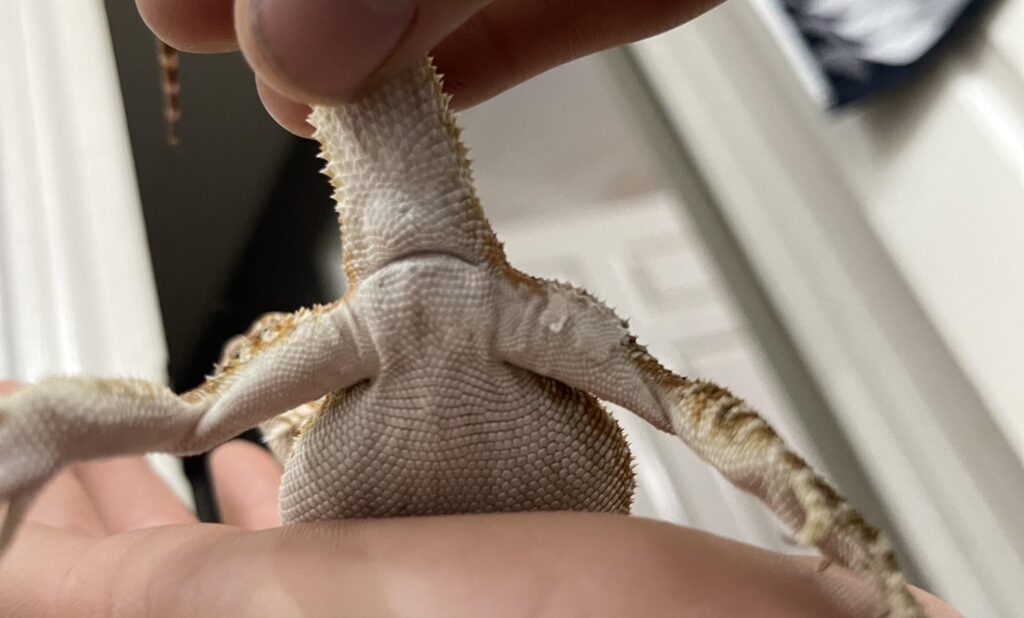
There exists only one sure way of telling the sex of a bearded dragon, and it comes from an internal examination of its reproductive organs. There are various methods such as ultrasound and x-rays which could be more accurate than physical examination.
Physical examination has been the most common way to determine the sex of bearded dragons since they are sexually mature.
- Determine if it’s male or female by looking at its coloration, checking for hemipenes, and pressing on the chest.
- Determine if it’s male or female externally by placing them in a clear plastic bag, turning the bag over so that their heads are caught in the neck of the bag, and then taking hold of them behind the neck – squeezing tightly enough that you don’t hurt your pet but firmly enough to ensure they stay put.
- Hold your beardie steady with one hand while you gently open his/her mouth with your other hand. The easiest is to press down on your beardie’s head with one hand while opening their mouth with the other.
- Once you have opened the mouth, look at the back of the throat to see if there are any structures that resemble balls or marbles – these would be the hemipenes that only male bearded dragons possess.
- If you can’t tell if your beardie is male or female by examining its external reproductive organs then it’s time for a physical examination of the internal organs located inside your pet’s abdomen. You will need someone to help you hold your beardie firmly in place for this procedure.
- Ask someone who has experience handling reptiles to assist you. Tell them not to do anything until they are instructed and also not to try and have sex with the beardie themselves, no matter how obvious it is to them, they must wait until you give permission in case they are wrong.
We recommend that one person holds the head and neck in a firm grip while another holds down the body in a similar fashion each needs to have sufficient experience in doing this or they may get bitten! - Take hold of your beardie by holding him/her around the neck with one hand while supporting their bottom with your other hand.
- In an upwards motion, lift your bearded dragon’s tail so that his abdomen is exposed.
- You will see a vent on either side of your pet’s belly, these are their cloacal openings where poop comes out from and where mating takes place. Check to see if there are two openings or just one if your beardie has a single cloaca then they are female and if you can see two distinct holes then your pet is male.
It is however unusual for these to be clearly visible to the naked eye, in which case you may need a magnifying glass in order to examine them closely enough. - If it’s male, gently press on its lower stomach with your index finger until you feel something hard inside. This could be its penis described as a firm tubular structure about 1/4 inch in diameter and 1-2 inches long located halfway down each side of his belly from the cloacal opening.
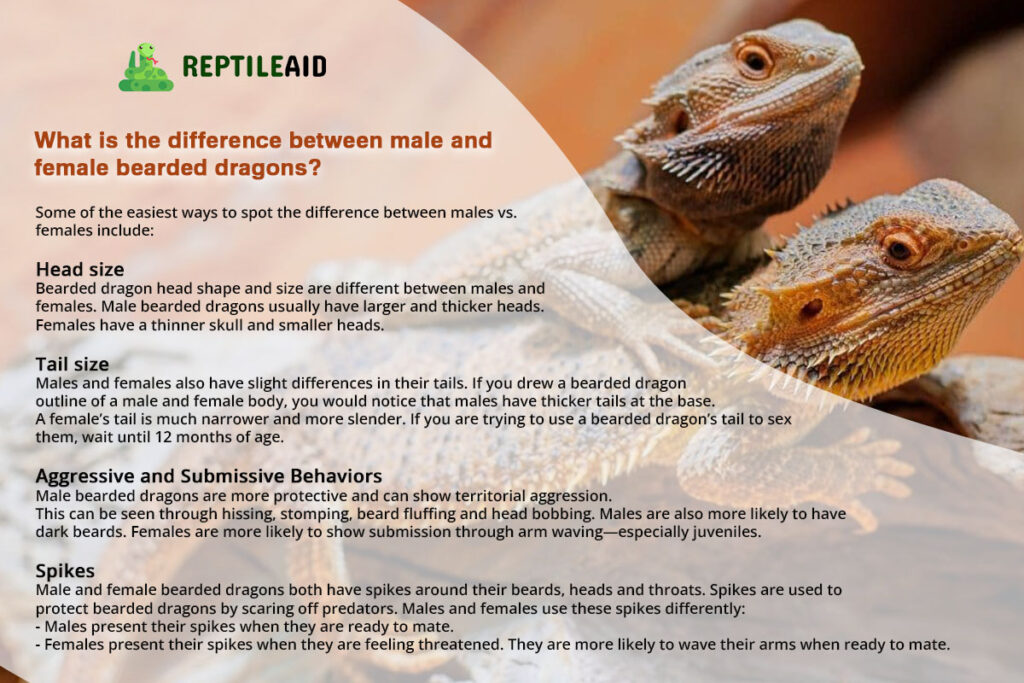
Conclusion
To conclude, the simplest answer I can give you on how to tell what your bearded dragon’s sex is by taking their temperature or looking at their coloration is this, take all three methods together and figure out which one works best for you.
